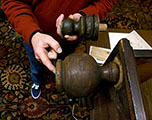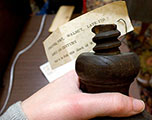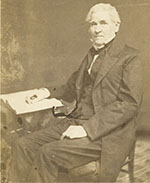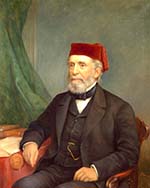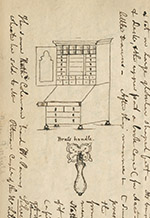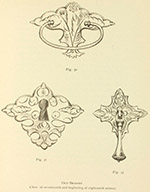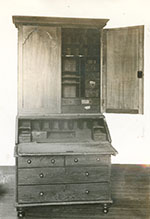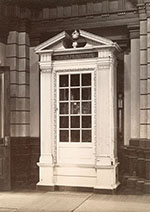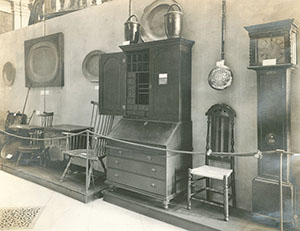Art & Artifacts
Discover the Library Company's Art and Artifact Collection
Penn's Desk
One of the Library Company’s treasures is a secretary desk formerly owned by William Penn. It has a wonderfully fascinating history. A recent discovery of one of the desk’s original feet led me to research its past further.

Secretary desk, owned by William Penn. Made in London, c. 1710.
Discovery of the Foot
Laura Keim, Historic Germantown Curator, came across a foot in the Germantown Historical Society’s collection with a label stating it belonged to the desk of William Penn. We already knew that the feet now on the desk were not original. To verify whether this foot had indeed belonged to the desk, furniture historian Adam Bowett was enlisted to help investigate the matter. He was able to determine that the foot was from the desk on the basis of several criteria: it was made of the right material (elm which was the favored wood for feet); it was correct stylistically; the threads inside the desk matched the screw on the foot; and it was the right height and diameter. Of course, the only way to be certain was to try it out. And it matched! But why was the foot separated from the desk in the first place? To find out, I had to trace the history of the desk’s ownership.
John Fanning Watson and John Jay Smith
Much of what we know about the desk and its provenance came from the early antiquarian John Fanning Watson (1779-1860) and our former Librarian John Jay Smith (1798-1881). Smith and Watson had a warm friendship. Both were born in Burlington County, N.J. and later lived in Germantown. They had similar interests in history and collecting items with historical associations. They co-authored a book, American Historical and Literary Curiosities (1846), which is filled with facsimiles of letters and autographs of notable people ranging from George Washington to Edgar Allan Poe. They enjoyed hunting down curiosities, writing in the preface that they “considered the work a ‘labor of love,’ in part rewarded by the pleasure of the pursuit.”1
Watson is probably best known for his book, Annals of Philadelphia: Being a Collection of Memoirs, Anecdotes, and Incidents of the City and Its Inhabitants, which was first published in 1830 and reprinted numerous times.2 The basis of the book came from his many interviews of “aged persons” regarding their memories of their early life, Philadelphia, the Revolution, and other notable events, as well as his searches through old documents and newspapers (often with the help of Smith). He enjoyed sketching old buildings and antiquities. He spent most of his life in Germantown and Philadelphia, working for thirty years as Cashier of the Bank of Germantown. Additionally, Watson was particularly interested in what he called “relics” -- items important because of their provenance. He grew interested in researching furniture originally at William Penn’s estate Pennsbury and visited it in1826.
Portrait of the antiquarian John Fanning Watson. ca. 1855. Photographic print, salted paper. Library Company of Philadelphia.
John Jay Smith (1798-1881) began his career in the drug business but always felt a penchant for literature, so in 1827 he began by publishing a newspaper called the Pennsylvania Gazette. In 1829, he left the Gazette to join the Library Company as Librarian. Smith recounted that at the time the Library was open from 2 o’clock until sundown, which left him time to pursue his interests.3 He later founded the Girard Life Insurance, Annuity, and Trust Company, as well as Laurel Hill Cemetery. After twenty-two years with the Library Company, he retired and his son Lloyd became the Librarian. He continued to write and edit until his death at the age of eighty-three.
Portrait of Librarian John Jay Smith. James Reid Lambdin (1807-1889). Oil on canvas. Library Company of Philadelphia.
Penn’s Desk Uncovered in Burlington, New Jersey
It was Smith who first found the desk. He wrote to Watson on May 8, 1827, “I have discovered in Burlington some relics from Pennsbury – an old man has Penns bookcase now in a dilapidated state.”4
The “old man” Smith was referring to was Nathaniel Coleman (1765-1842), a Burlington silversmith. Smith had known Coleman since he was a young boy, and Coleman’s shop occupied what was formerly his grandfather’s house. Smith described him in the manuscript version of his Recollections, a passage that did not appear in the 1892 published version.
“…Nathaniel Coleman, a silversmith of great local renown, remarkable for having continuously displayed, during all my boyhood and youth, the same pair of sugartongs and two slevebuttons, in his little front shop window formed in the entry front wall. This house is the identical one of my grandfather John Smith, though now only half of it, two large mansions having been made out of one. Natty wa[s] [a]friend of mine, allowing me to look on, or blow his bellows, while he manipulated or mended silver spoons and coffee pots. As a proof of his affection he gave me the initials J.S., cut by my grandfather in one of the panes of glass.”5
Smith went on to describe the desk to Watson, who replied, “I must however go yet & see the Relics—You are a true Disciple to have ferreted out such rarities!”6
Watson then visited the desk in person. His description follows:
I saw also in the possession of Nathl Coleman, a Silver Smith in Burlington the old fashioned Book Case of Wm Penn, now used as shop-Closet in his work shop, in very old & unsightly condition –It was formed of English Oak, vaneer’d all over with mahogany, & sat on large globular shaped feet—Its base was a chest of Drawers & Desk, & the upper part a book Case (for Accot-books only) & numerous little drawers –After this manner:- (Some Remains of it I have preserved—The Doors of the Book-apartment was formed of two plates of mirror—measuring 31 by 14 Inchs.-) Nathl Coleman became possessed of it in 1792, from George Dylwin (a friend family) (sic) whose family got it from Pennsbury Estate through the hands of Peter Worrell.7
One of the “remains” that he preserved was a brass handle, which is now in the collection of Winterthur Museum, Garden and Library. The brass has an accompanying label in Watson’s hand dated 1827. Additionally, he drew a sketch of the desk and handle.
Sketch made by Watson of the desk and the brass handle. John F. Watson’s Annals of Philadelphia, 1829. Image courtesy of the Historical Society of Pennsylvania.
Looking Glasses
The desk originally had looking glasses on the doors, and these excited Smith and Watson both. After Smith first learned of the desk at Coleman’s shop he wrote to Watson that the desk “…had doors inlaid with looking glasses, which are removed & hang in his parlour. One is in good condition – he will trade it for a good modern one. It would be something to view ones self in the same mirror as he did. …What value would you set on Penn’s Looking glass? its too small for a modern parlour--”8 Watson replied that he would “buy the glasses.”9 “A thought! Apply to some of the old furniture houses of 2d hand good & there you’ll find plain old looking glass “‘dog cheap’” & procure us each one to give Nathaniel “‘the Israelite indeed’” –Remember his plate was 31 by 14 Inch.”10
Watson never purchased the mirrors. Perhaps Coleman decided he wanted to keep them or was unsatisfied with their modern replacements. Coleman died in 1842, and the mirrors remained in the family. His wife Elizabeth died in 1845, and her estate’s inventory listed “1 Looking Glass formerly Wm Penn’s” appraised at $2.11 Her will left this “Looking Glass formerly attached to the Book case of Wm Penn” to her granddaughter Mary L Newbold and further notes that “the mate” had already been given to her granddaughter Elizabeth Nicholson “some time ago.”12 How exciting to think that it is possible that the mirrors may turn up!13
Feet as Mantle Ornaments
Smith the relic hunter was able to successfully obtain the feet of the desk. Smith told Watson, “The feet of the said bookcase (which is E oak inlaid with mahogany) are now detached – have a monstrous screw to attach them to the bottom – are also of Eng oak & the size & shape of a quart jug – I hooked them & brought them along – if you’ll promise to use them as mantle ornaments! I’ll give you one pair. ”14 Naturally, Watson replied “My mantle shall fall upon you! Yes I’ll use the Book Case feet.”15 While Watson did not get his hands on the mirrors, he did, however, own the feet writing in Annals of Philadelphia, that “the original feet are in my possession.”16 One of the feet, we now know, is at the Germantown Historical Society. And there may still be others surviving!
Provenance
Coleman had the desk in his possession when he died in 1842; an inventory of his estate listed in his workshop, “sundry old silversmith tools, stove, chairs, and a book-case desk.”17 Perhaps Smith acquired it soon afterwards. Watson’s 1844 edition of Annals of Philadelphia stated that the desk “formerly in possession of Nathaniel Coleman” was “now in possession of the Philadelphia Library.”18 John Jay Smith had to have owned it at that time and displayed it in the Library before formally gifting it in 1873.
According to Watson, Coleman acquired the desk from George Dillwyn, whose family had obtained it from Peter Worrall when the contents of Pennsbury Manor, William Penn’s estate, were sold in 1792.
There is yet another Smith connection to the desk, for George Dillwyn was Smith’s great uncle. Smith wrote, “George Dillwyn, the eminent preacher, married my grandmother Morris’s sister, Sarah Hill, and resided in Burlington, near, in every sense, to my grandma.”19 Smith amusingly wrote of his uncle, “we rarely went to Uncle Dillwyn’s, and he rarely came to our house, or to my grandmother’s, without a sitting, a sermon, and a prayer.” As a child Smith thought that “these long and frequent evening sittings were beyond measure annoying. I cannot truthfully use any other phrase.”20 Dillwyn died childless in 1820 at the age of 82.
George Dillwyn and his wife, Sarah Hill, John Jay Smith’s great uncle and aunt.
Restoration
When the Library Company received the desk it already had been altered, the mirrors were removed, and the handles and feet had been replaced. The Library further restored the desk in 1896. George Maurice Abbot was at the time one of the Library Company’s Directors and Treasurer; he later was the Librarian from 1907 to 1927. Abbot sought advice about restoration from Irving W. Lyon, a writer of several books on furniture. Lyon wrote, “as to the doors, they should be made of the same wood as the rest of the piece--with raised panels of wood, and not with glass.” He cautioned to avoid a “the modern German cabinet maker who does not care so much about keeping the piece as it was made, as in making a ‘slick’ looking job of ‘restoration.’” Lyon referred to several illustrations in his book, The Colonial Furniture of New England, to show how the desk should look. It appears Abbot took some of Lyons recommendations including not replacing the missing mirrors and modeling the brasses after figures in his book. (The brasses don’t resemble the authentic handle saved by Watson. See fig. 7). But Abbot did not follow other suggestions, such as making raised panels on the doors. Lyon also noticed that “the feet do not look quite right.”21 But the feet were not altered during the restoration. Curiously, there is a pediment with urn at the top of desk that was later removed. It’s possible that Abbot was trying to make it “match” our air pump case (compare fig. 12-13). The fact that all three photographs appear on the same page in a Library Company scrapbook strengthens this theory.22
The air pump case in the Ridgway building. It is the earliest surviving, documented piece of American furniture in the Palladian style. It was constructed in 1739 to house an air pump that John Penn sent to the Library Company from England.
The Desk in the Twentieth Century
From December 1920 through January 1921, the Pennsylvania Museum (which later became the Philadelphia Museum of Art) held a special exhibition in commemoration of the tercentenary of the landing of the Pilgrims. The Pennsylvania Museum displayed colonial relics in its Memorial Hall at Fairmount Park. The Museum borrowed a number of artifacts from the Library Company in addition to the desk, including a clock owned by William Penn, Meschianza-related items (a ticket, two silhouettes, and a poem written by Major John André), and our leather fire buckets.23 The urn and pediment atop the desk when it was first restored had already been removed by 1920 (compare fig. 11 & 14).
“Library Co. relics at the Colonial Loan Exhibition of the Penn Museum, Dec.-Jan. 1920-1921.” Library Company artifacts pictured are the desk, fire buckets atop the desk, and Penn’s clock on the right.
William Penn’s secretary desk has gone through many changes in its over 300-year history. Please come and see the desk in person on view in our Logan Room
Linda August
Curator of Art & Artifacts
___________________________________________
1 Smith, John Jay and John Fanning Watson. American Historical and Literary Curiosities. Philadelphia: Smith, 1847.
2 Copies of Watson’s manuscript notes are in the Library Company, Historical Society of Pennsylvania, and Winterthur and include drawings and sketches, watercolors, ephemera, and swatches of fabric.
3 Smith, John Jay. Recollections of John Jay Smith. Philadelphia: J.B. Lippincott Company, 1892, p.91.
4 Smith to Watson, May 8 1827, Letters & Communications to John F. Watson, 1823-1828. Am 30163, box 2, p. 229. Historical Society of Pennsylvania.
5 Smith, John Jay. [Recollections of John Jay Smith]. Manuscript. *Am 1892 8442.F, p. 110. LCP. John Jay Smith’s grandfather John Smith (1722-1771) was a Quaker merchant also born in Burlington who married James Logan’s daughter Hannah.
6 Watson to Smith, Smith Manuscript 7299.F13.90 May 11, 1827 LCP
7 John F. Watson’s Annals of Philadelphia, 1829. Historical Society of Pennsylvania.
8 Smith to Watson, May 8 1827, Letters & Communications to John F. Watson, 1823-1828. Am 30163, box 2, p. 229. Historical Society of Pennsylvania.
9 Watson to Smith, Smith Manuscript 7299.F13.90 May 11, 1827 LCP
10 Watson to Smith, Smith Manuscript 7299.F13.92 May 25, 1827 LCP. Watson alludes to John1:47: “Behold an Israelite indeed, in whom is no guile!”
11 Probate papers. Elizabeth Coleman’s inventory, 1845, Burlington County, New Jersey. New Jersey State Archives, 15122C.
12 Probate papers. Elizabeth Coleman’s will, 1845, Burlington County, New Jersey. New Jersey State Archives, 15122C.
13 Coleman had removed the mirrors from the doors of the desk and decorated his parlor with them. A watercolor of the Coleman’s parlor showing the mirrors hanging on the wall is in the Burlington County Historical Society’s collection.
14 Smith to Watson, May 8 1827, Letters & Communications to John F. Watson, 1823-1828. Am 30163, box 2, p. 229. Historical Society of Pennsylvania.
15 Watson to Smith, Smith Manuscript 7299.F13.90 May 11, 1827 LCP
16 Watson, John Fanning. Annals of Philadelphia. Philadelphia : E.L. Carey & A. Hart; G. & C.H. Carvill, 1830, p. 733.
17 Willburn, Pansylea Howard. “Quaker Silversmith, Nathaniel Coleman,” Silver Magazine (Jan./Feb. 2001), p. 36.
18 Watson, John Fanning. Annals of Philadelphia. Philadelphia : E.L. Carey & A. Hart; G. & C.H. Carvill, 1830, p. 733. Watson, John Fanning. Annals of Philadelphia. Philadelphia: the author, 1844, p. 501.
19 Smith, John Jay. Recollections of John Jay Smith. Philadelphia: J.B. Lippincott Company, 1892. p.18.
20 Smith, John Jay. Recollections of John Jay Smith. Philadelphia: J.B. Lippincott Company, 1892, p. 52.
21 Lyon, Irving W. to George Maurice Abbot, Jan. 20, 1896. LCP Archives OBJ 005.
22 Figures 9-11 appear on the same page of a scrapbook in the Library Company’s collection, Moran 1717.F.52.
23 Library Company Directors’ Minutes, vol. 11, Jan. 6 and March 3, 1921, p. 222, 227.

